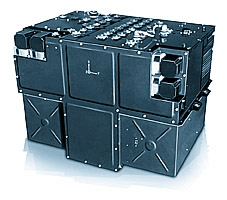Argon-16 Computer
Home → Articles → Argon Family of Computers → Argon-16 Computer
- Airborne Argon-16 computer system.
- Chief designers: N. N. Solovyov, M.Sc., A. T. Yeryomin, M.Sc., G. D. Monakhov, M.Sc.
Development engineer: F.S. Vlasov.
- Designing organization: Research Institute of Computer Engineering (NICEVT) of the USSR Ministry of Radio Engineering (since 1986 - Research Institute NII Argon).

Argon-16 Computer
- Manufacturer: Kalmykov SAM factory of the USSR, Moscow.
- Completion of development: 1973.
- Beginning of production: 1974.
- Termination of production: still in production.
- Field of application: control systems of Soyuz and Progress spaceships, Salyut, Mir and Almaz space stations.
- Total output of machines: 380.
- Description: synchronous computer system with triple redundancy and majorization being carried out on per unit base with eight levels. It consists of three computers with data channels and a set of interfaces to the control system. The instruction set is specially designed for control tasks. I/O operations are combined with the calculation process.
Representation of numbers - fixed point.
Word length: 16 bits (word), 32 bits (double word); instruction length - 16 bits. Number of instructions - 32.
Speed: addition - 5 ms, multiplication - 45 ms.
RAM capacity: 3 x 2 Kbytes, ROM capacity - 3 x 16 Kbytes.
Interrupt system - one level from 16 sources. Number of multiplex I/O channels - 1 x 3.
Data rate - up to 80,000 Kbps.
I/O devices include analog-to-digital converter, digital-to-analog converter; code-to-interval and code-to-pulse converters; unit of relay signals with 72 inputs and 65 outputs; receiver and transmitter of serial code; tape drive interface and printer interface.
- Element base: 106, 115 and 134 family ICs.
- Design: the computer contains a computing and exchange unit, a RAM module, three ROM modules and an interface unit to the controlled object. All of them are mechanically combined and electrically connected comprising an entity. The printed circuit boards of all units are assembled in a book-like package and interconnected by a special rubber "spine" with flexible wires. Cooling is carried out by a forced ventilation system.
- Technology: unified multilayer double-sided printed circuit boards produced by laminating. ICs are surface-mounted.
- Software: a standard program set; special subroutines.
An automated programming system including an autocode with a compiler based on M-220 computer; an automated debugging system based on M-222 computer; a set of tests.
- Specifications:
Range of operating temperatures - from 0 to +40°C operating temperatures.
Volume - 145 qdm.
Weight - 70 kg.
Power consumption - 280 W.
MTBF - 10,000 h.
- Special features: extremely high reliability due to tripled synchronous structure with hardware majorization and technical solutions including printed circuit boards produced by laminating. During 25 years of operation no failures of the system were noted when working in control systems. By the production volume it is unrivalled among space computers.



